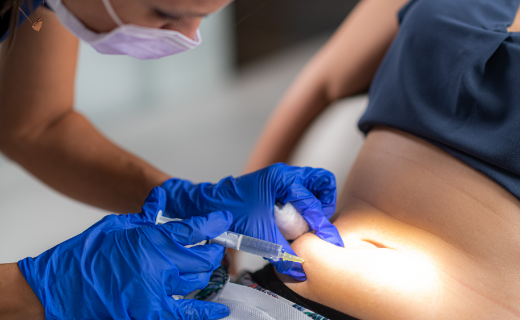
Abnehmen durch Injektionslipolyse?
Die Injektionslipoyse ist eine beliebte Behandlung in der ästhetischen Medizin, welche zur gezielten Beseitigung kleiner bis mittlerer Fettpölsterchen angewandt…

Some of the most commonly used antioxidants come from the substance class of vitamins. One of the most important used in cosmetic dermatology is retinol.
It is often equated with vitamin A. However, vitamin A represents a group of substances, so that the correct term for retinol is actually vitamin A1. It was first discovered in 1913 by Elmer McCollum and Marguerite Davis.
They described it as a fat-soluble vitamin and demonstrated its importance as an antixerophthalmic factor (1). Twenty years later, Paul Karrer successfully isolated retinol from fish liver oil.
Many years ago, after treating acne patients with retinoids, clinicians noted a reduction in the appearance of skin lines, which subsequently led to the increased use of vitamin A derivatives.
Currently, retinol represents one of the most commonly used substances in anti-aging preparations. It is listed in the 20th edition of the World Health Organization’s List of Essential Medicines, where the most effective and safe medicines needed in a health system are included (2).
Although this substance group is one of the longest used and best-studied anti-aging agents in cosmetic dermatology, its precise mechanism of action has not yet been fully elucidated.
Scientifically well documented, however, are the positive effects on collagen metabolism. Collagen is the main structural protein in various connective tissues in the body. It is one of the body’s key natural resources and a component of skin tissue that can positively influence wound healing. Studies on topical application show that retinol, as well as retinoic acid, can induce collagen synthesis (3).
In a randomized, double-blind, vehicle-controlled, left and right arm comparison study, the application of a 0,4% retinol lotion showed a significant induction of glycosaminoglycan, a substance known to retain substantial amounts of water, as well as an increase in collagen production. These effects are most likely responsible for the previously noted wrinkle effacement (4).
In further in vivo studies (tested on humans), remarkable changes in the mechanical properties of the skin could be found after the application of retinol. Epidermal keratinocytes, the cells of our upper layer of the skin, grew and regenerated faster.
In addition, dermal endothelial cells and fibroblasts, cells that stimulate the production of type I collagen and other important substances like fibronectin and elastin, were stimulated. These results were confirmed by the significant facial anti-aging effect (5,6).
Nevertheless, a high volume-percentage of retinol can also be a challenge for robust skin. Sensitive skin should tolerate the use of preparations containing less than 0.03% retinol. However, blemishes, dryness, flakiness, redness, tingling, stinging, burning, desquamation, and solar sensitivity may appear on sensitive skin.
These symptoms often result in limited utility of the products, as well as decreased adherence, due to irritation reactions (7).
Pregnant and lactating women should not use preparations containing retinoids due to their teratogenicity, although the risk from the use of topical preparations is extremely low compared to systemic intake (8).
In conclusion, irritating agents shouldn’t be used in daily skin care, especially given the large diversity of other non-irritating anti-aging ingredients. If products with retinol are used, it is best to start with an application of three times per week, gradually increasing the dosage and frequency as needed.

Abnehmen durch Injektionslipolyse?
Die Injektionslipoyse ist eine beliebte Behandlung in der ästhetischen Medizin, welche zur gezielten Beseitigung kleiner bis mittlerer Fettpölsterchen angewandt…

Antioxidants aid in the prevention of the development of chronic diseases. Common examples include compounds derived specifically from plants…

Ärztliches Honorar in der Ästhetik
Da es sich bei ästhetischen Behandlungen ausschließlich um Privatleistungen handelt, sind diese auch für die behandelnden Ärzte durchaus profitabel. Doch was ver…

We will call you back soon